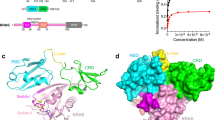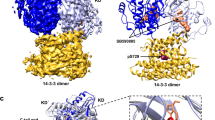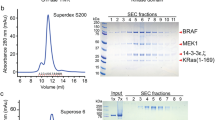Abstract
Ras is a small GTPase that cycles between an inactive GDP-bound and an active GTP-bound form. A large variety of ligands that stimulate cell surface receptors induce the activation of Ras. Thus far, this activation could only be measured by the increase of GTP bound to Ras, which was precipitated from radio-labelled cell extract. We have used the minimal Ras-binding domain (RBD) of Raf1 (aa 51-131) to identify in vivo activated Ras. This novel method is based on the observation that RBD binds RasGTP in vitro with a Kd of 20 nM whereas the affinity between RBD and RasGDP is three orders of magnitude lower. Here we show that the Gst-RBD fusion protein precipitates transfected RasL61 (RasGTP) but not RasN17 (RasGDP) from cell lysates. In addition, we demonstrate for two different cell lines that the increase in RasGTP is reflected by an increase in Ras bound to Gst-RBD. From these results we conclude that the minimal Ras-binding domain of Raf1 is an excellent activation specific-probe for Ras.
This is a preview of subscription content, access via your institution
Access options
Subscribe to this journal
Receive 50 print issues and online access
$259.00 per year
only $5.18 per issue
Buy this article
- Purchase on Springer Link
- Instant access to full article PDF
Prices may be subject to local taxes which are calculated during checkout
Similar content being viewed by others
Author information
Authors and Affiliations
Rights and permissions
About this article
Cite this article
de Rooij, J., Bos, J. Minimal Ras-binding domain of Raf1 can be used as an activation-specific probe for Ras. Oncogene 14, 623–625 (1997). https://doi.org/10.1038/sj.onc.1201005
Received:
Revised:
Accepted:
Issue Date:
DOI: https://doi.org/10.1038/sj.onc.1201005
Keywords
This article is cited by
-
Expression of oncogenic HRAS in human Rh28 and RMS-YM rhabdomyosarcoma cells leads to oncogene-induced senescence
Scientific Reports (2021)
-
Discovery of a dual Ras and ARF6 inhibitor from a GPCR endocytosis screen
Nature Communications (2021)
-
Akt-mediated Ephexin1–Ras interaction promotes oncogenic Ras signaling and colorectal and lung cancer cell proliferation
Cell Death & Disease (2021)
-
Small Molecule KRAS Agonist for Mutant KRAS Cancer Therapy
Molecular Cancer (2019)
-
Macropinocytosis, mTORC1 and cellular growth control
Cellular and Molecular Life Sciences (2018)



